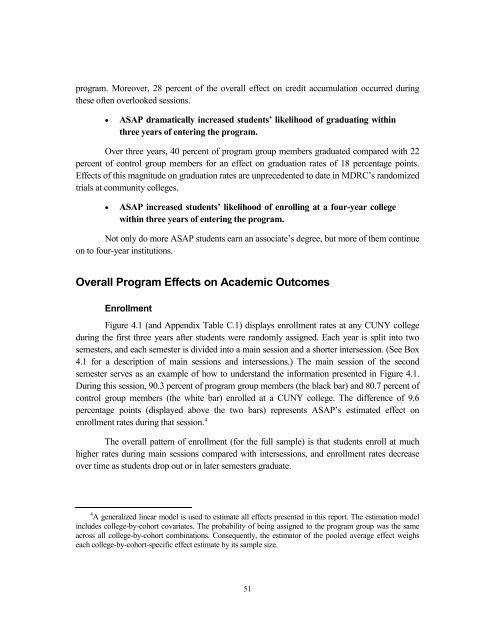1dOprzL
1dOprzL
1dOprzL
Create successful ePaper yourself
Turn your PDF publications into a flip-book with our unique Google optimized e-Paper software.
program. Moreover, 28 percent of the overall effect on credit accumulation occurred duringthese often overlooked sessions.• ASAP dramatically increased students’ likelihood of graduating withinthree years of entering the program.Over three years, 40 percent of program group members graduated compared with 22percent of control group members for an effect on graduation rates of 18 percentage points.Effects of this magnitude on graduation rates are unprecedented to date in MDRC’s randomizedtrials at community colleges.• ASAP increased students’ likelihood of enrolling at a four-year collegewithin three years of entering the program.Not only do more ASAP students earn an associate’s degree, but more of them continueon to four-year institutions.Overall Program Effects on Academic OutcomesEnrollmentFigure 4.1 (and Appendix Table C.1) displays enrollment rates at any CUNY collegeduring the first three years after students were randomly assigned. Each year is split into twosemesters, and each semester is divided into a main session and a shorter intersession. (See Box4.1 for a description of main sessions and intersessions.) The main session of the secondsemester serves as an example of how to understand the information presented in Figure 4.1.During this session, 90.3 percent of program group members (the black bar) and 80.7 percent ofcontrol group members (the white bar) enrolled at a CUNY college. The difference of 9.6percentage points (displayed above the two bars) represents ASAP’s estimated effect onenrollment rates during that session. 4The overall pattern of enrollment (for the full sample) is that students enroll at muchhigher rates during main sessions compared with intersessions, and enrollment rates decreaseover time as students drop out or in later semesters graduate.4 A generalized linear model is used to estimate all effects presented in this report. The estimation modelincludes college-by-cohort covariates. The probability of being assigned to the program group was the sameacross all college-by-cohort combinations. Consequently, the estimator of the pooled average effect weighseach college-by-cohort-specific effect estimate by its sample size.51


